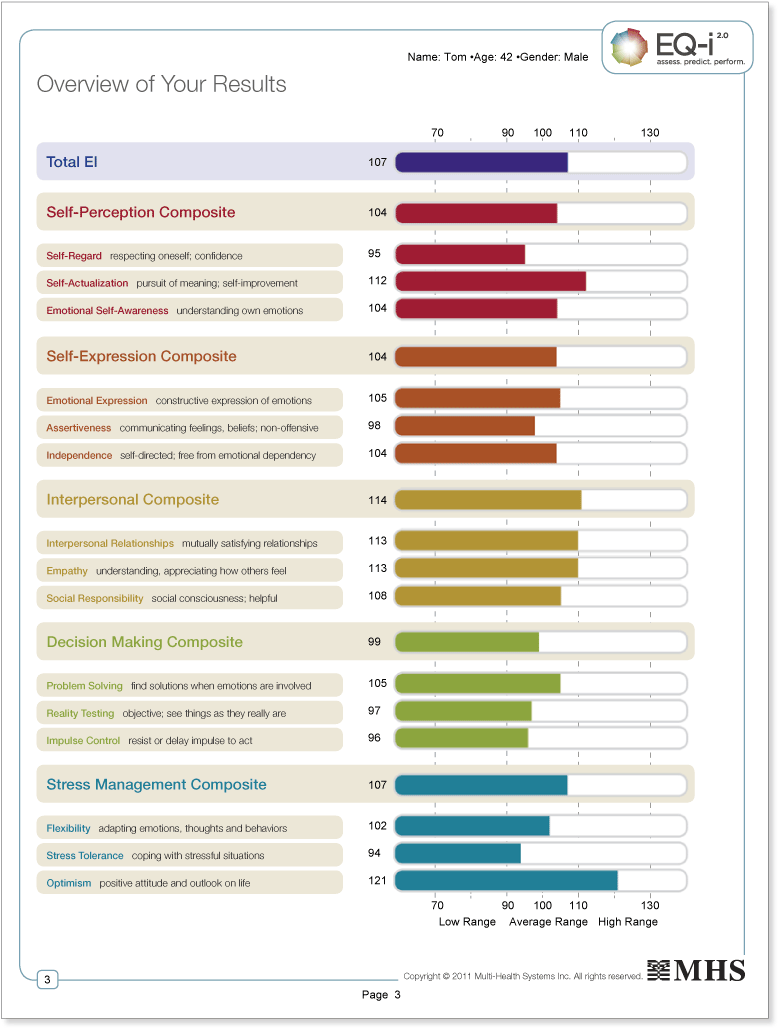Part IV: Using the Results
EQ-i 2.0 Case Studies
Case Study 3
Submitted by: Dana Ackley
Client Background
Tom is a 40-year-old husband and father of two. Tom is a professional with an advanced degree, who works as a senior executive in a not-for-profit organization, leading a team of five colleagues. Tom has a solid history of success working within organizations. When he attempted to begin his own business, his success was adequate but not outstanding. He found that he missed the connectedness that he felt working for an institution. He returned to his current employer, who asked him to turn around a department currently in disarray.
Tom described himself as highly optimistic with lots of positive emotional energy. He saw himself as skilled in creating harmony within his work team. He succeeded in turning the performance of his department around by using his high level of positive energy and genuine enjoyment of people. However, Tom was also able to articulate limitations in his approach. He said: “I don’t do well with conflict. When someone disagrees, I nod but don’t raise my concerns.” He took the EQ-i 2.0 in order to identify barriers to managing conflict, having tough conversations and making use of “teaching moments.”
Summary of EQ-i 2.0 Results

All of Tom’s EQ-i 2.0 scores are average or better, consistent with the success he has had in his career and as a leader. While he does not have any low scores, the differences that exist among scores shed light on his strengths and opportunities.
His self-description was highly consistent with his EQ-i 2.0 profile. The Interpersonal Composite shows strong interpersonal skills across the board. He is good with people. His high scores on Optimism and Happiness speak to his ability to create high levels of positive energy that draw others to him, creating a positive context within which he can lead and influence people.
All of Tom’s EQ-i 2.0 scores are average or better, consistent with the success he has had in his career and as a leader. While he does not have any low scores, the differences that exist among scores shed light on his strengths and opportunities.
His self-description was highly consistent with his EQ-i 2.0 profile. The Interpersonal Composite shows strong interpersonal skills across the board. He is good with people. His high scores on Optimism and Happiness speak to his ability to create high levels of positive energy that draw others to him, creating a positive context within which he can lead and influence people.
Consistent with his report of difficulty with conflict, Tom’s scores on Assertiveness and Self-Regard are relatively low. To avoid conflict, he too often puts others’ wishes ahead of his own, rather than strive for a functional balance. This pattern has an erosive effect on Tom’s Self-Regard.
His relatively low score on Stress Tolerance signals the anxiety he reports during conflict. Impulse Control is also relatively low, consistent with anxiety impacting decision making about what to do when faced with conflict. Interestingly, once Tom gets some distance from the event, he begins to think more clearly, using skills consistent with his high score on Optimism. Instead of staying anxious, he begins to think in resilient ways. He thinks about possibilities instead of barriers.
In discussing his positive attitude, he noted “I can be kind of myopic sometimes.” This reflection is consistent with his relatively low score on Reality Testing. He tends to wear rose-colored glasses, missing signs that might warn him that a conflict may be on the horizon. He doesn’t want to see conflict because he has little confidence in his ability to handle it.
Tom has devoted himself to self-development in many aspects of his life. He spent years in foreign countries to learn their languages and cultures. He earned a professional degree for the intellectual development it offered. His high Self-Actualization score is consistent with that history and predicts a positive response to attempts to build EI skills that need attention.
Coaching Approach & Development Strategies
Clearly Tom needs to become more assertive. And he knows it. His barrier has not been that knowledge. Instead, he had not recognized the role that anxiety plays in the process. Review of the EQ-i 2.0 profile helped identify the sequence of denial, recognition of conflict, anxiety, and then retreat. Before he can be more assertive in conflict situations, Tom needs to learn to manage that initial anxious response. Discussing the profile provided us a context within which we could identify the roots of his anxiety over conflict. “Connecting the dots” often removes much of the power of past experiences.
Learning the role of anxiety in his conflict avoidance motivated Tom to build his Stress Tolerance skills, especially within conflict situations. Exercises in the EQ Leader Program Manual (Ackley, 2006) were provided. Once he has built those skills, he will be ready to learn better Assertiveness skills. With the anxiety under control, that is likely to happen fairly quickly for someone with this man’s overall EI skills. And when Tom is ready to focus on Assertiveness, a variety of exercises can provide the necessary framework for development. It is quite likely that as he improves in his ability to manage conflict, his Self-Regard skills will improve largely on their own because he will have more balance in seeing to his needs and those of other people.